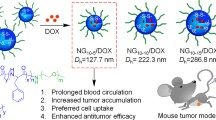Abstract
We developed novel poly(l-lysine) [poly(Lys)] derivative nanogels with smart drug release properties. Poly(Lys) derivative was prepared after the chemical reaction of poly(Lys) and 3-diethylaminopropyl isothiocyanate (DEAP), and was coupled with poly(ethylene glycol) (PEG). The obtained poly(Lys-DEAP)-b-PEG was crosslinked by genipin (crosslinking agent) in an oil/water emulsion condition, producing poly(Lys) derivative nanogels. These nanogels (~95 nm in diameter, pH 7.4) showed volume expansion (~200 nm in diameter) in the endosomal pH (~pH 6.0) due to extensive proton absorption of DEAP moieties in the crosslinked nanogel core. These nanogels reversibly swelled at pH 6.0 and shrank at pH 7.4, correspond to maximized drug release at pH 6.0 and minimized drug release at pH 7.4. We conclude that this nanogel system will have great potential for tumor therapy.







Similar content being viewed by others
References
Ferrari M, Barker A, Downing G (2005) A cancer nanotechnology strategy. Nanobiotechnol 1:129–131
Gillies ER, Frechet JM (2005) pH-responsive copolymer assemblies for controlled release of doxorubicin. Bioconjug Chem 16:361–368
Lee ES, Na K, Bae YH (2005) Doxorubicin loaded pH-sensitive polymeric micelles for reversal of resistant MCF-7 tumor. J Control Release 103:405–418
Lee ES, Kim D, Youn YS, Oh KT, Bae YH (2008) A virus-mimetic nanogel vehicle. Angew Chem Int Ed 47:2418–2421
Lee BR, Oh KT, Oh YT, Baik HJ, Park SY, Youn YS, Lee ES (2011) A novel pH-responsive polysaccharidic ionic complex for proapoptotic (KLAKLAK)2 peptide delivery. Chem Commun 47:3852–3854
Maeda H, Matsumura Y (2011) EPR effect based drug design and clinical outlook for enhanced cancer chemotherapy. Adv Drug Deliv Rev 63:129–130
Oh KT, Yin H, Lee ES, Bae YH (2007) Polymeric nanovehicles for anticancer drugs with triggering release mechanisms. J Mater Chem 17:3987–4001
Oh NM, Oh KT, Baik HJ, Lee BR, Lee AH, Youn YS, Lee ES (2010) A self-organized 3-diethylaminopropyl-bearing glycol chitosan nanogel for tumor acidic pH targeting: evaluation. Coll Surf B Biointerfaces 78:120–126
Oh NM, Kwag DS, Park SY, Oh KT, Youn YS, Lee ES (2012) Electrostatic charge conversion processes in engineered tumor-identifying polypeptides for targeted chemotherapy. Biomaterial 33:1884–1893
Oh NM, Oh KT, Youn YS, Lee DK, Cha KH, Lee DH, Lee ES (2013) Poly(l-aspartic acid) nanogels for lysosome-selective antitumor drug delivery. Coll Surf B Biointerfaces 101:298–306
Park SY, Baik HJ, Oh YT, Oh KT, Youn YS, Lee ES (2011) A smart polysaccharide/drug conjugate for photodynamic therapy. Angew Chem Int Ed 50:1644–1647
Schmaljohann D (2006) Thermo- and pH-responsive polymers in drug delivery. Adv Drug Deliv Rev 58:1655–1670
Stubbs M, McSheehy PM, Griffiths JR, Bashford CL (2000) Causes and consequences of tumour acidity and implications for treatment. Mol Med Today 6:15–19
Tannock IF, Rotin D (1989) Acid pH in tumors and its potential for therapeutic exploitation. Cancer Res 49:4373–4384
van Dijk-Wolthuis WNE, van de Water L, van de Wetering P, van Steenbergen MJ, van den Bosch JJK, Schuyl WJW, Hennink WE (1997) Synthesis and characterization of poly-l-lysine with controlled low molecular weight. Macromol Chem Phys 198:3893–3906
Wang SS, Hsieh PL, Chen PS, Chen YT, Jan JS (2013) Genipin-cross-linked poly(l-lysine)-based hydrogels: synthesis, characterization, and drug encapsulation. Coll Surf B Biointerfaces 111C:423–431
Acknowledgments
This articel does not contain any studies with human and animal subjects performed by any of the authors. These authors (M.J. Lee, N.M. Oh, K.T. Oh, Y.S. Youn, E.S. Lee) declare that they have no conflict of interest. This work was financially supported by the GRRC program of Gyeonggi province [GRRC 2013-B01, Development of industrial nano-/micro-sized biomaterials for high performance drug release control], and Basic Science Research Program through the National Research Foundation of Korea (NRF) funded by the Ministry of Education (NRF-2013R1A1A2004375).
Author information
Authors and Affiliations
Corresponding author
Rights and permissions
About this article
Cite this article
Lee, M.J., Oh, N.M., Oh, K.T. et al. Functional poly(l-lysine) derivative nanogels with acidic pH-pulsed antitumor drug release properties. Journal of Pharmaceutical Investigation 44, 351–356 (2014). https://doi.org/10.1007/s40005-014-0130-7
Received:
Accepted:
Published:
Issue Date:
DOI: https://doi.org/10.1007/s40005-014-0130-7




